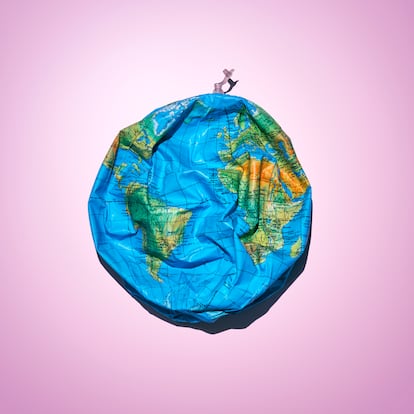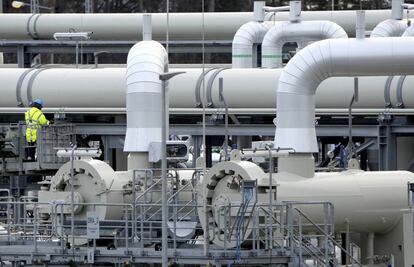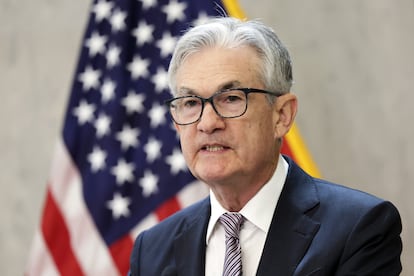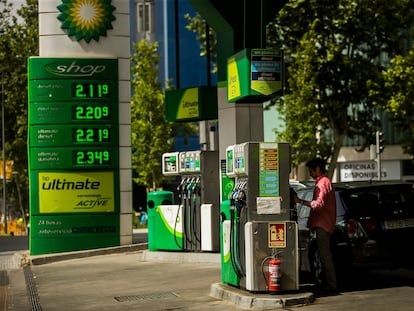As the global economy deflates, here is what the coming crisis looks like
Inflation has thrown everything out of whack. Rising interest rates will bring, at the very least, a notable slowdown in the pace of growth

Last October, during the presentation of its World Economic Outlook, the International Monetary Fund (IMF) stated that “the global recovery is underway despite the resurgence of the pandemic.” The world’s growth was expected to be 4.9% in 2022.
In January of this year, however, the IMF’s projection for global GDP growth was lowered to 4.4%. In April, it was cut even further, leaving it at 3.6%, mostly as a result of the economic damage inflicted by the war in Ukraine.
Inflation - which already spiked at the end of 2021 due to rising employment and growing demand after the restrictions imposed by Covid-19 - has run amok to levels not seen in 40 years, mostly due to supply chain bottlenecks and the sharp rebound in energy costs. What was initially seen as a transitory situation has taken root, as the armed conflict in Ukraine stalls and second-round inflationary waves arrive.
Last year, to curb inflation by shrinking the money supply, the main central banks drew up a roadmap for the gradual withdrawal of economic stimulus, while still keeping interest rates low to give investors and borrowers breathing room in the post-pandemic years. This strategy of slowly increasing the price of money and shrinking federal balance sheets was laid to waste by Putin’s invasion. The Federal Reserve, the Bank of England and the European Central Bank have been forced to give a sharp turn and accelerate interest rate hikes to try and stifle burgeoning inflation, by slowing the levels of borrowing and consumer spending.
In a world addicted to liquidity since the response to the 2008-9 Great Recession, a much tighter monetary policy is a heavy blow to growth prospects. In addition to rising prices and interest rates, the world will now likely have to contend with higher unemployment. However, each region has its own peculiarities. In the following reports, we analyze the situation of the world’s four major economic zones.

EUROPEAN UNION
The euro zone walks a tightrope again
LLUÍS PELLICER
The European economy is walking along a narrow tightrope, trying to maintain its balance in the face of two tumultuous forces: rising energy prices and declining growth. Both are intensifying as the invasion of Ukraine continues.
Everything indicates that Southern Europe is preparing to shine this summer, with its coastlines well-populated after two years of restrictions. However, the recovery may skid due to a number of factors: the escalation of the war, the supply-chain bottlenecks created by China’s intense lockdowns, or the tightening of monetary policy. The European recovery fund - endowed with €800 billion until 2027- will be a necessary buffer in the coming months.
“Everything indicates that we are going to have a good summer, but in September it can change. We are going [through] a stage in which we are going to have higher prices and weaker growth,” says María Jesús Valdemoros, a lecturer in economics at the University of Navarra in northern Spain.
The main risk to the recovery is if Putin cuts off the gas supply to Europe. The European Central Bank (ECB) estimates that this would weigh on economic growth in the eurozone, so that it would grow only 1.3% in 2022 and contract by 1.7% in 2023, while inflation would increase even more than the 8% currently registered. Just a week ago, the German government was forced to raise its alert level due to the forecast of not being able to fill gas tanks by autumn. And therein lies the main fear of Frankfurt and Brussels: that Germany will enter a recession and drag down the rest of its partners.
The influential Munich-based Ifo Institute for Economic Research does not foresee that this extreme will occur, but it notes that all the blows received as a result of the war in Ukraine and the lockdowns in China are going to cost Germany 1.5% of GDP. In a normal year, the agency maintains, the country would have already entered a recession.
Faced with this situation, the ECB has debated between raising rates - despite the risk of strangling growth - or maintaining a more lax policy with the threat that prices will continue to skyrocket. For now, it has decided to raise its key interest rates by 0.25% in July and probably 0.50% in September.
For the inflation “hawks,” the Eurobank is too late, especially when the rest of the central banks have been raising rates for months. The “doves,” with the memory of the ECB’s ill-timed rate hikes that curbed recovery efforts in 2011, fear that a hasty increase will cause an economic slowdown… especially if there is yet another external blow, whether it comes from Moscow or Beijing.
As a precaution, several EU governments have acted to cushion their populations from inflation. For instance, Spain has given out bonuses for the most vulnerable workers and reduced the price of transit passes. However, international institutions, from the IMF to the European Commission, are asking for financial reserves to be rebuilt. And, with Germany at the forefront, some governments are warning about overspending.
“It is time to get out of [such] policies. Inflation is high and governments should not make it continue to grow through spending,” says Clemens Fuest, president of Ifo. “It’s a bad decision.”
Forecasts indicate that there are many risks that cloud growth. “Households are seeing their income reduced. Real wage growth has been negative for two consecutive quarters,” said Christine Lagarde, president of the ECB.
There is a possibility that the clouds will dissipate, if, say, the war in Ukraine were to end. But in the event that hostilities continue and the economic battle between Brussels and Moscow persists, it remains to be seen how high energy prices will rise, how far governments can go and when the central banks will run out of cash.

UNITED STATES
Rising prices stop the country from reaching full employment
MIGUEL JIMÉNEZ
Job offers are obvious throughout the nation’s capital: in the windows of banks, clothing stores, supermarkets, movie theaters. It is estimated that, in the United States, there are twice as many vacancies as there are unemployed individuals. The country is nearing full employment. And yet, the economic situation has sunk the popularity of President Joe Biden and threatens his party’s control of the Senate and the House of Representatives in the November midterm elections. Blame it on inflation.
Prices have risen 8.6% in the past year - the biggest increase in four decades. But the daily reminder to Americans that prices are skyrocketing is the cost of fuel. Gasoline has increased in price by more than 60%. On average, it costs about $5 per gallon. There are places where it’s around $8. Furthermore, inflation has entrenched itself and spread to more and more products, from grocery aisles to hotels.
Federal Reserve Chair Jerome Powell has vowed to stabilize prices, even if it comes at the cost of a recession. What he is looking for is a so-called “soft landing,” or to control inflation without the economy contracting and unemployment skyrocketing. In his last Senate appearance, Democratic Senator Elizabeth Warren snapped at him: “You know what’s worse than high inflation and low unemployment? It’s high inflation and a recession with millions of people out of work.”
Powell himself admits that his wiggle room for a soft landing is slim. The Federal Reserve has already made three rate hikes, the last of them being 0.75 points. This is the largest increase since 1994. By the end of 2022, the rates will be between 3% and 3.5%, and next year close to 4%, according to the Fed’s projections. The withdrawal of liquidity will slow down the economy.
Will this lead to recession? “It is not what we are looking for, but it is a possibility,” was Powell’s response before the Senate.
Last week, the IMF lowered its growth forecasts for the United States from 3.7% to 2.9% this year and from 2.3% to 1.7% for the next. It is expected that in 2024, growth will be a mere 0.8%.
“The most likely outlook is very weak growth and persistently high inflation. We see about a 40% chance of a recession next year,” says Ethan S. Harris, global economist at Bank of America Securities.
Recession or not, economic malaise is already palpable. A report published in June indicated that 36% of those who earn more than $250,000 a year (four times the median salary) live paycheck-to-paycheck. If a significant part of the most privileged echelon feels that they can barely make ends meet, it is easy to imagine how the rest of Americans are doing.

UK
The City sees dark clouds
RAFA DE MIGUEL
After the Bank of England’s (BoE) warning last May that the UK economy would enter a slight recession at the end of 2022, the hard-right of the Conservative Party demanded that the Prime Minister lower taxes. This year, public sector workers have called strikes throughout the summer to demand salary increases compatible with galloping inflation nearing double digits.
Both PM Johnson and Chancellor Rishi Sunak have been trying to contain pressure from their party and the general population, to avoid further aggravating inflation with lower taxes or exorbitant wage increases.
“What is most worrying is that this inflation has been concentrated in what could be called basic goods,” said Andrew Bailey, Governor of the BoE. “Basically, energy and food.”
This is to say that the crisis, above all, affects the poorest citizens. Although the BoE suggests that there could be a modest recovery by early 2023 - thus avoiding two consecutive quarters of GDP decline, or the technical definition of a recession - it is anticipated that the UK will see growth decline next year by 0.25%.
The average price per household for gas and electricity shot up almost €800 in April, and it will reach more than €3,000 (annually) by October. In May, the government approved a 25% windfall tax on the profits of oil and gas companies. Much of this tax was intended to finance single-payment subsidies to millions of households, between €400 and €1,000, to meet the exorbitant cost of living.
The BoE, like other central banks, has reacted late, but with impetus. So far this year, interest rates have already risen to 1%. Focused on combating inflation, the looming economic storms have not been reason enough for the monetary authority to relax its drastic decision. “I am aware of the harsh consequences this will have for many people, particularly those with lower incomes and little savings,” Bailey admitted after announcing the decision. It will now be harder for small and medium-sized businesses to borrow and expand, and for consumers to pay off credit cards and loans.
Johnson now faces a three-pronged problem: voters angry with the galloping rise in prices; some MPs, desperate to keep their seats, demanding lower taxes; and exhausted public accounts after two years of pandemic spending.

CHINA
The dragon’s ailments grow
MACARENA VIDAL LIY
Chinese Premier Li Keqiang’s meeting with officials on May 25 was unusual because of its size—nearly 100,000 local officials participated in the video call—but also because of his frankness. The head of government acknowledged that the difficulties facing the second world power’s economy are more serious than in the worst moment of the pandemic, when it contracted for the first time in 30 years.
A lethal combination of lockdowns in some of the country’s major cities - including the closure of Shanghai, its financial heart, throughout April and much of May - the war in Ukraine and the crisis in the real estate sector left alarming numbers in April. Most analysts have downgraded their growth prospects for the Asian giant this year. Few, even within official circles, believe that the government’s objective of a GDP increase of around 5.5% for 2022 will be met. The World Bank calculates 4.3%. Other entities, such as the Swiss UBS, forecast 3%.
Consumer confidence has suffered a severe blow. In April, retail sales fell by 11.1%; in May, by 6.7%. Even the consumption of cosmetics has decreased, products that have never stopped seeing their sales grow since China entered the World Trade Organization 20 years ago. Youth unemployment stands at 18.4%, well-above the average of the European Union (13.9%) or the United States (7.8%). The entry of 10.76 million recent college graduates into the market this summer will grow that number even further.
Experts say that the massive confinements, together with constant PCR testing, are mainly responsible for this economic anemia. “The only predictable thing about China right now is its unpredictability, and that is poison for the business climate,” said Bettina Schoen-Behanzin, the VP of the European Chamber of Commerce in China, at the presentation of her institution’s annual report on the confidence of European companies in the Asian country. Sixty percent of the companies included in the report said that doing business in China had become more difficult, and 49% cited Covid among the three main reasons why.
So far, Beijing has introduced relatively modest stimulus measures, including tax breaks for small and medium-sized businesses and increased spending on infrastructure. The most recent data is beginning to show some bright spots: for instance, industrial production for May grew by 0.7%, after a 3% contraction in April. But analysts from Nomura Holdings note that although the reopening of cities “has raised optimism in the short-term, we do not see it as a change in trend, given that the Covid-zero policy will continue until the beginning of 2023.” Possible risks in the coming months are new lockdowns to stem Covid outbreaks, drastic corrections to support the weakened housing market, or problems related to the high debt of local governments.
Although performing below original forecasts, and far from repeating the driving role it played in the 2008 financial crisis, the Chinese economy will continue to grow. “China is not going to enter a recession,” says Alicia García-Herrero, chief economist for Asia at the investment bank Natixis. Neither “is it going to be a source of global recession, but it will be a source of slowdown, to which it contributes to the extent that it does not grow as much as its potential.”
García-Herrero also notes that China is helping to export inflation to the rest of the world. The Beijing government has imposed restrictions on the export of items such as fertilizers and some steel products; the subsequent shortages have triggered international price increases.
“This is an additional source of tension, given that China exports a third of the world’s intermediate goods,” she warns.
Tu suscripción se está usando en otro dispositivo
¿Quieres añadir otro usuario a tu suscripción?
Si continúas leyendo en este dispositivo, no se podrá leer en el otro.
FlechaTu suscripción se está usando en otro dispositivo y solo puedes acceder a EL PAÍS desde un dispositivo a la vez.
Si quieres compartir tu cuenta, cambia tu suscripción a la modalidad Premium, así podrás añadir otro usuario. Cada uno accederá con su propia cuenta de email, lo que os permitirá personalizar vuestra experiencia en EL PAÍS.
¿Tienes una suscripción de empresa? Accede aquí para contratar más cuentas.
En el caso de no saber quién está usando tu cuenta, te recomendamos cambiar tu contraseña aquí.
Si decides continuar compartiendo tu cuenta, este mensaje se mostrará en tu dispositivo y en el de la otra persona que está usando tu cuenta de forma indefinida, afectando a tu experiencia de lectura. Puedes consultar aquí los términos y condiciones de la suscripción digital.
More information
Últimas noticias
Maduro pleads not guilty before the federal court in New York: ‘I am still the president of Venezuela’
A new test can detect Alzheimer’s from a finger prick
UN team enters Sudanese city of El Fasher after paramilitary massacre: ‘It’s like a ghost town’
A recipe for resistance: Indigenous peoples politicize their struggles from the kitchen
Most viewed
- Gilles Lipovetsky: ‘If you want to live better and fall in love, take Prozac, don’t look to philosophy’
- Alain Aspect, Nobel laureate in physics: ‘Einstein was so smart that he would have had to recognize quantum entanglement’
- Alvin Hellerstein, a 92-year-old judge appointed by Bill Clinton, to preside over Maduro’s trial in New York
- Why oil has been at the center of Venezuela-US conflicts for decades
- Maduro’s downfall puts China’s relationship with Venezuela to the test










































